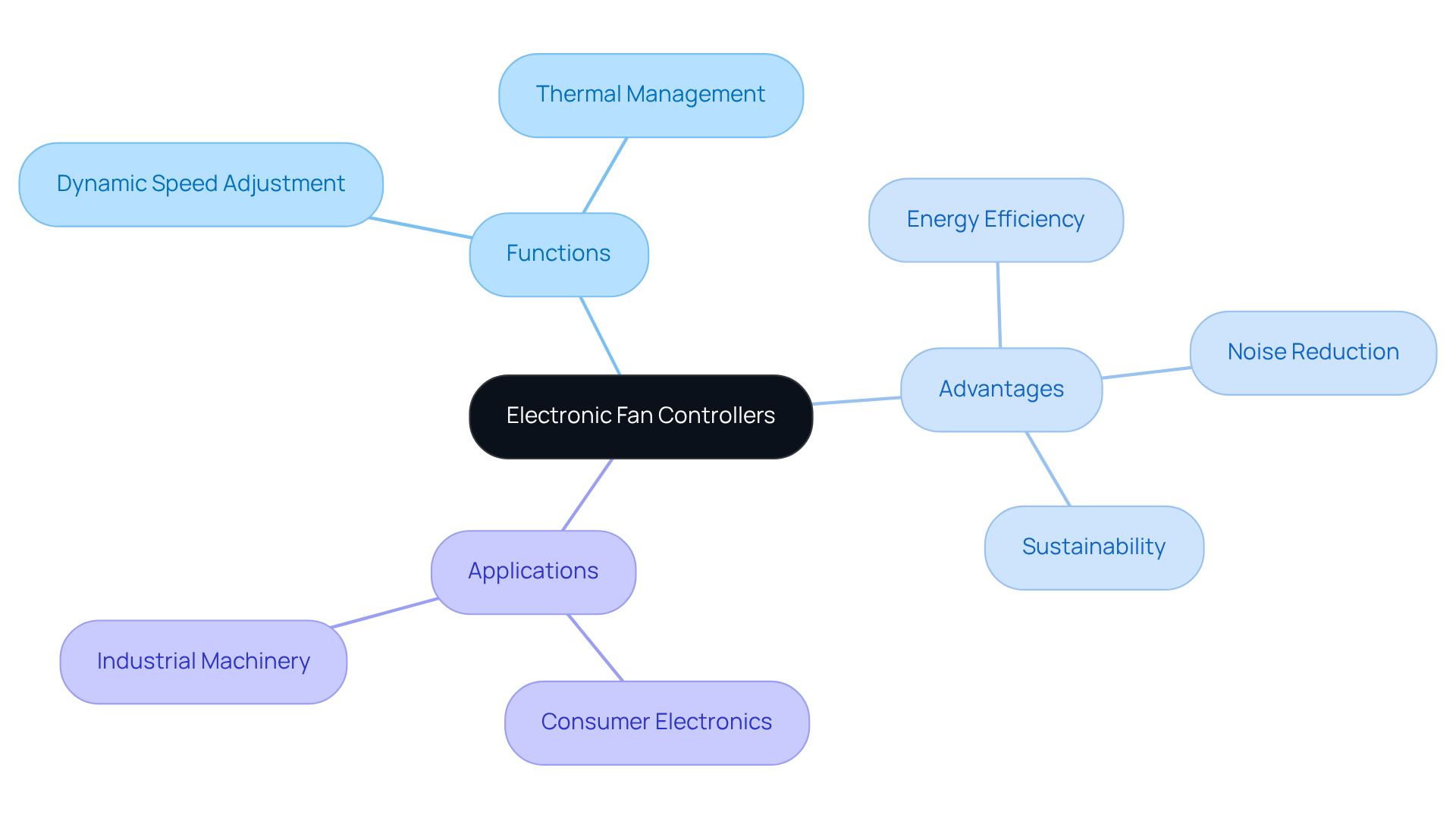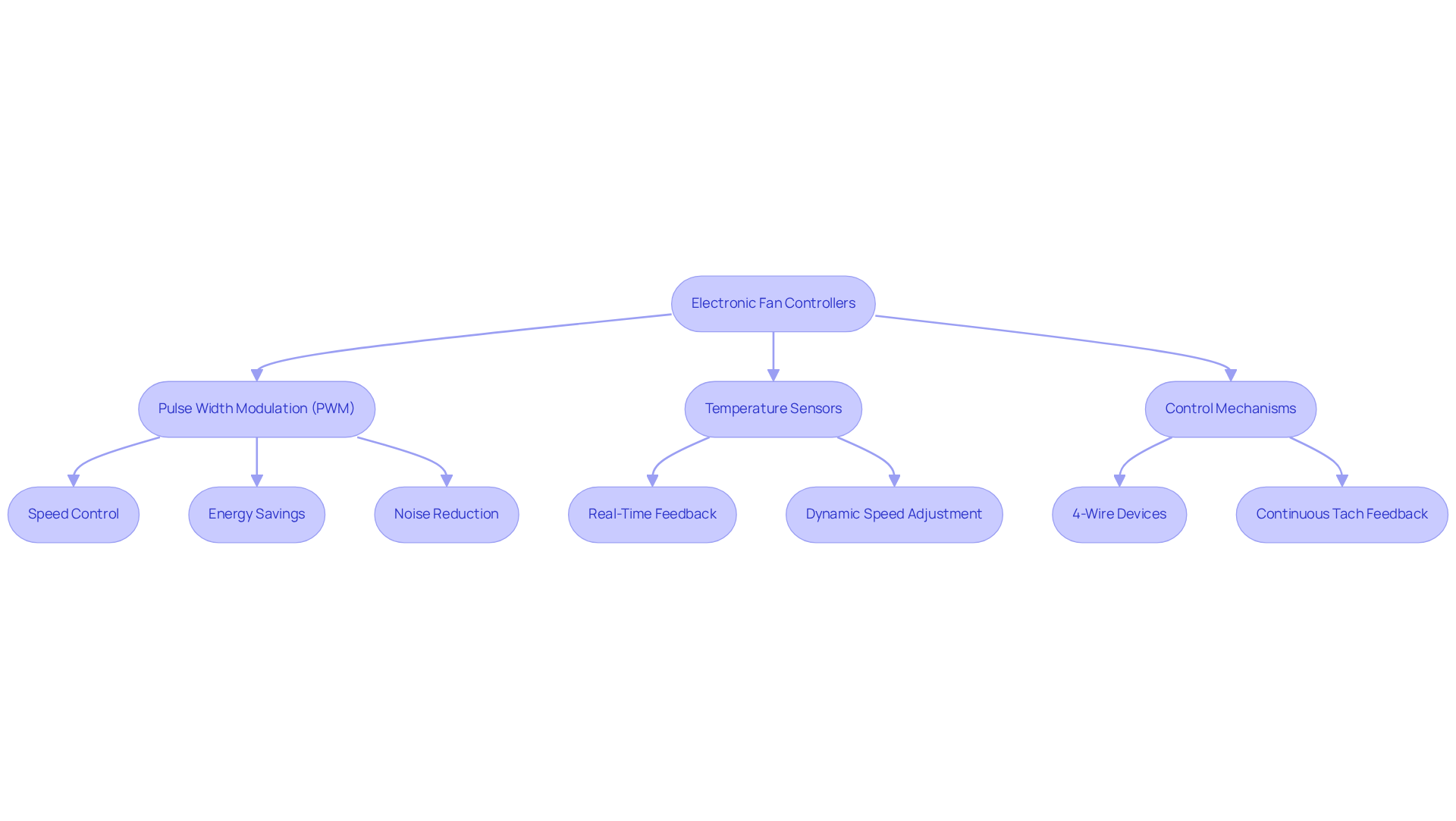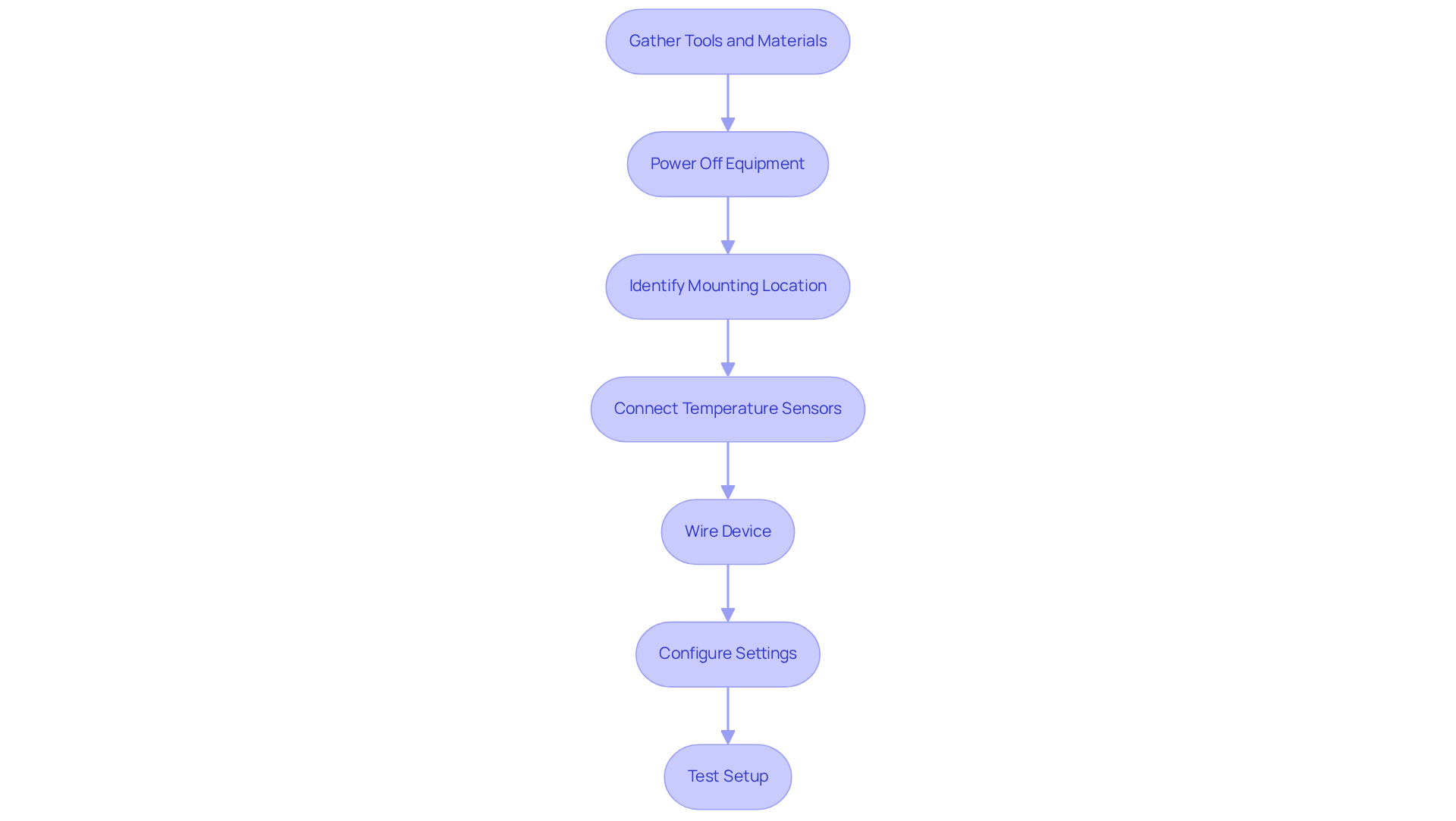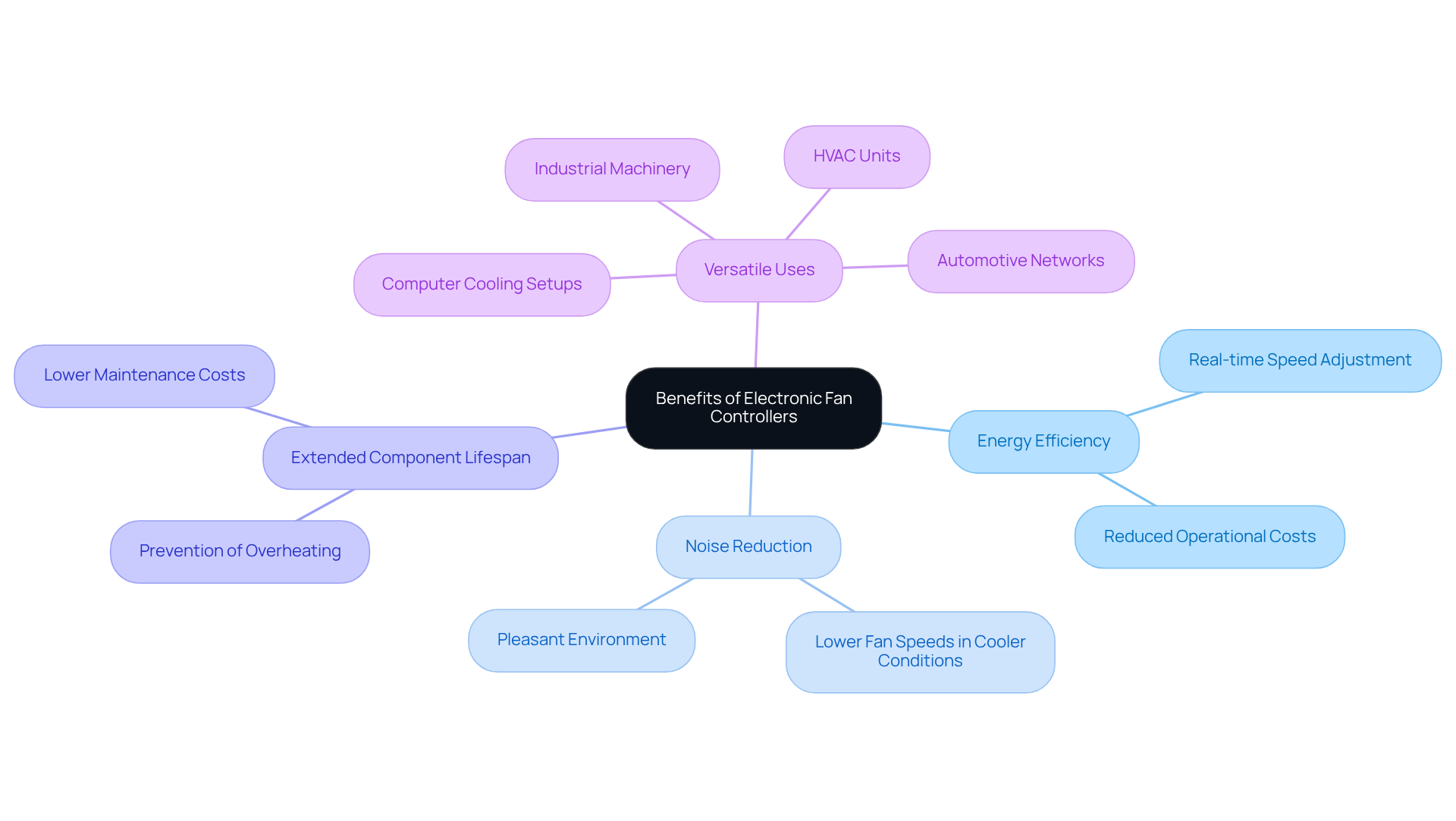Overview
Electronic fan controllers are essential devices that optimize cooling by dynamically adjusting fan speeds based on real-time temperature and environmental conditions. This functionality is crucial in preventing overheating and extending the lifespan of components. The significance of these controllers is underscored by their numerous benefits, including:
- Enhanced energy efficiency
- Noise reduction
- Versatility across various applications
Advanced technologies such as Pulse Width Modulation and temperature sensors play a pivotal role in improving both performance and reliability. These innovations not only contribute to the effective management of thermal conditions but also ensure that systems operate at optimal efficiency. As a result, the implementation of electronic fan controllers is not merely a technical enhancement; it is a strategic decision that can lead to significant operational advantages.
Introduction
Electronic fan controllers have emerged as vital components in modern electronic systems, ensuring optimal thermal management and enhancing overall performance. By intelligently adjusting fan speeds based on real-time temperature data, these devices not only prevent overheating but also contribute to energy efficiency and noise reduction.
However, with the rapid advancements in technology, how can users effectively navigate the installation process and fully leverage the benefits of these sophisticated controllers?
This article delves into the intricacies of electronic fan controllers, offering a comprehensive guide to their installation and highlighting their significant advantages across various applications.
Define Electronic Fan Controllers and Their Importance
An electronic fan controller serves as a sophisticated device that dynamically adjusts fan speeds according to temperature and environmental conditions. Their primary function is to maintain optimal thermal conditions within electronic systems, effectively preventing overheating and prolonging the lifespan of components. By modifying fan speeds in real-time, these devices significantly enhance cooling efficiency, which is vital across numerous applications, ranging from consumer electronics to industrial machinery.
Gagner-Toomey Associates, recognized as the world’s largest manufacturer of standard and custom air-movers, offers a comprehensive range of innovative cooling solutions tailored for electronics. This includes DC input tube axial fans and centrifugal blowers that are optimized for performance, efficiency, and low noise. The advantages of electronic fan regulators extend beyond mere thermal management; they also enhance energy efficiency and reduce noise levels, contributing to a more sustainable operation.
For instance, the deployment of intelligent fan regulators in data centers has demonstrated the potential to lower energy usage by as much as 30%, all while preserving essential temperature limits. Recent advancements in technology, particularly the integration of AI and IoT capabilities, have further improved the functionality of these devices, enabling predictive maintenance and remote monitoring. This evolution not only addresses the increasing complexity of contemporary systems but also aligns with sustainability objectives by minimizing energy waste.
In summary, an electronic fan controller is indispensable for effective thermal management, ensuring that devices operate within safe temperature ranges and enhancing their overall performance.

Explain the Technology Behind Electronic Fan Controllers
Electronic fan controllers utilize advanced technologies to enhance fan performance and energy efficiency. A prominent method employed is Pulse Width Modulation (PWM), which modulates the voltage supplied to the fan, allowing for precise speed control. This technique not only enhances operational efficiency but also results in significant energy savings compared to traditional voltage regulation methods. For instance, high-frequency PWM can enable fans to operate at speeds as low as 10% of their maximum capacity, reducing power consumption and extending the lifespan of the components.
Temperature sensors play a crucial role in these systems by providing real-time thermal feedback. This integration enables the operator to dynamically modify fan speeds according to real thermal conditions, ensuring optimal cooling performance. By utilizing temperature sensors, fan controllers can enhance efficiency, as they respond to varying heat loads rather than depending on fixed speed settings. This adaptability is particularly beneficial in compact electronic devices, where smaller components generate more heat due to higher processing power.
The integration of PWM technology and an electronic fan controller, along with temperature sensor technology, not only improves cooling efficiency but also enhances overall reliability. Recent advancements in these areas have led to more sophisticated control mechanisms, enabling engineers to design systems that are both quieter and more energy-efficient. For instance, 4-wire devices permit continuous tach feedback, enhancing control precision and facilitating accurate speed adjustments. As highlighted by Mary Burke, high-frequency PWM is favored because of its efficiency and decreased noise, as it enables devices to operate at lower speeds while ensuring effective cooling. Furthermore, while linear control methods can provide quiet operation, they often require higher voltage to start fans, leading to inefficiencies. As a result, the integration of these technologies, such as the electronic fan controller, is becoming standard practice in contemporary fan control systems.

Guide to Installing Electronic Fan Controllers
Installing electronic fan controllers requires careful attention to several key steps to ensure optimal performance and safety:
-
Gather Necessary Tools and Materials: Begin by ensuring you have the appropriate tools, such as screwdrivers, wire strippers, and connectors, along with the fan regulator and any required sensors. This preparation is crucial for a smooth installation process.
-
Power Off the Equipment: Prior to commencing installation, it is essential to turn off the electronic device. This step is vital to prevent any electrical hazards that could arise during the installation process.
-
Identify Mounting Location: Select an appropriate location for the device, ensuring it is both accessible and has adequate airflow. Proper placement is key to the effective functioning of the fan controller.
-
Connect Temperature Sensors: If your device utilizes temperature sensors, install them in locations that accurately reflect the thermal conditions of the setup. This accuracy will enhance the responsiveness of the fan controller.
-
Wire the Device: Proceed to connect the device to the power supply and the fans according to the manufacturer’s wiring diagram. Ensure that all connections are secure to prevent any potential shorts, which could compromise the system’s integrity.
-
Configure Settings: After installation, adjust the device’s settings to meet the specific needs of your setup, including temperature thresholds and fan speed profiles. Tailoring these settings will optimize performance.
-
Test the Setup: Finally, activate the setup and observe the device’s operation. Confirm that it responds accurately to temperature fluctuations and adjusts fan speeds as expected.
By adhering to these steps, users can efficiently set up fan regulators, thereby enhancing their system’s cooling capabilities.

Discuss Benefits and Applications of Electronic Fan Controllers
Electronic fan controllers offer numerous benefits that are essential for optimizing cooling in electronic systems, including:
- Energy Efficiency: By adjusting fan speeds based on real-time conditions, these controllers significantly reduce unnecessary energy consumption, leading to lower operational costs.
- Noise Reduction: Operating at lower fan speeds during cooler conditions minimizes noise, thereby creating a more pleasant environment in both residential and commercial settings.
- Extended Component Lifespan: By preventing overheating, fan regulators assist in prolonging the lifespan of delicate components, which ultimately lowers maintenance and replacement expenses.
- Versatile Uses: These devices find application across a broad spectrum, from computer cooling setups and HVAC units to industrial machinery and automotive networks. Their adaptability makes them suitable for various environments and requirements.
In summary, the electronic fan controller is not merely an accessory; it is an essential tool that provides significant advantages in efficiency, noise reduction, and component longevity.

Conclusion
Electronic fan controllers are essential components in contemporary electronic systems, expertly managing fan speeds to optimize cooling and elevate overall performance. Their capacity to adapt to real-time temperature fluctuations not only mitigates the risk of overheating but also enhances energy efficiency and minimizes noise levels. This makes them indispensable across a wide range of applications.
In this article, we explored key insights into the technology underpinning electronic fan controllers, including Pulse Width Modulation (PWM) and temperature sensor integration. These elements work in concert to improve cooling efficiency and reliability. Furthermore, a comprehensive guide to the installation process outlined critical steps necessary for a successful setup, underscoring the importance of meticulous preparation and configuration.
The relevance of electronic fan controllers transcends basic functionality; they signify a pivotal advancement in thermal management technology. As industries increasingly emphasize energy efficiency and sustainability, the adoption of electronic fan controllers can yield significant operational advantages. By implementing these systems, users not only enhance the durability of their equipment but also contribute to a more sustainable future.
Frequently Asked Questions
What is an electronic fan controller?
An electronic fan controller is a device that dynamically adjusts fan speeds based on temperature and environmental conditions to maintain optimal thermal conditions within electronic systems.
Why are electronic fan controllers important?
They prevent overheating, prolong the lifespan of components, and enhance cooling efficiency, which is crucial for various applications, including consumer electronics and industrial machinery.
What are some advantages of using electronic fan regulators?
Electronic fan regulators improve energy efficiency, reduce noise levels, and contribute to sustainable operation, as they can lower energy usage significantly while maintaining essential temperature limits.
How much energy can intelligent fan regulators save in data centers?
Intelligent fan regulators can lower energy usage by as much as 30% in data centers.
What recent advancements have been made in electronic fan controllers?
Recent advancements include the integration of AI and IoT capabilities, which enhance functionality by enabling predictive maintenance and remote monitoring.
How do electronic fan controllers contribute to sustainability?
They minimize energy waste and align with sustainability objectives by optimizing cooling efficiency and reducing overall energy consumption.
Who is a recognized manufacturer of electronic fan controllers and cooling solutions?
Gagner-Toomey Associates is recognized as the world’s largest manufacturer of standard and custom air-movers, offering a range of innovative cooling solutions tailored for electronics.

